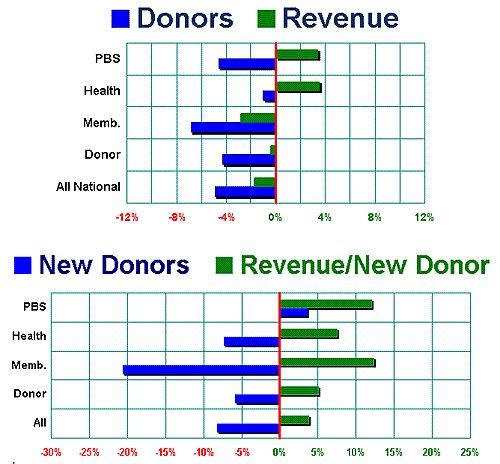|
9/11 One Year Later: Lasting Impact or Moment in Time? The anniversary of September 11th provides a milestone for looking back on the preceding 12 months to understand what, if anything, direct marketers and fundraisers can learn from the terrorist tragedies and anthrax scares. Based on anecdotal and empiric research, it appears that the principles of direct marketing and fundraising hold as true as ever. In hindsight, it also looks now like the events of September 2001, rather than being the defining moment for charities, was a "wake up call" signaling a fundamental transformation of our industry that was well underway before last September. Survey Findings
Interestingly, however, at least one organization that back-tested these changes found that the changes actually hurt revenue! In other words, maintaining tried-and-true techniques, in spite of unique circumstances, may be the best approach. In addition to the anecdotal results noted above, Target Analysis Group (http://www.targetanalysis.com/) compared actual results data from a group of 24 national nonprofits and 15 bellwether Public Broadcasting Service (PBS) stations. The data show that most organizations' results were softening prior to September, most likely due to the economic slowdown. When comparing the periods July-March 2001 to March-July 2002 and broken down by various sectors, the data show that only PBS stations and health charities held their own and grew from a revenue perspective. Higher giving by smaller numbers of supporters accounts for this increase in revenue. Membership, donor and aggregated national organizations showed declines in both revenue and numbers of supporters. The biggest impact seems to have been in acquisition, with all categories of organization, excepting PBS, showing declines in numbers of new donors. The declines ranged from just over 5 percent to more than 20 percent. Other key findings include:
Clearly, in these findings, there are important lessons learned about direct marketing and fundraising in the wake of Sept. 11. Additionally, it is important to look more broadly at what has worked in the past, the impacts of a national tragedy and the changing landscape ahead. From this vantage point, the events of a year ago appear to be a "wake-up call" to begin addressing the fundamental shifts taking place in our society and that undoubtedly will affect fundraising. These transformations include:
Development professionals would be wise to take this opportunity to work with their leadership and the Boards of their organizations to invest now in strategies that will address some of the changes that are on the horizon. Most of these ideas are not new, but clearly the direct marketing and fundraising profession now is at a crossroads. These trends which once seemed far in the future are now closer at hand, and the events of a year ago have opened a door to organizational change that might not have otherwise opened. Now is the time to move forward in new and different directions. Are there new media that should be explored in conjunction with or in lieu of mail? Are there new audiences, such as Hispanics, women and Gen X'ers who warrant special strategies? Are there things we can say to or do with our supporters to assure them that their trust in us is not misplaced? In short, the key is figuring out how we must change if we want to continue to be successful in the future. About the Authors Phyllis Freedman is Senior Vice President, Client Services, Epsilon. For more than 30 years, Epsilon has been leading the way in innovative direct marketing and database management solutions to meet the fundraising needs of nonprofit organizations. In March 1999, Nonprofit Times named Freedman as one of 12 women driving direct response fund raising. Mary Beth McIntyre is Vice President, Innovation Services, Target Analysis Group. Target Analysis Group provides innovative data analysis, market research, donor relationship management and database marketing services to nonprofit organizations, helping them to build successful direct response fundraising programs. McIntyre also is a member of the Board of Directors of the Direct Marketing Association Nonprofit Federation. |
|



